Using View Options for Geometry Selection
Introduction
This topic explains how to use the view options, shaded, wireframe, and transparent to make geometry selection easier. Note that the information here can be applied to CAD and CAM.
Example Part
The following image shows an example part with the default viewing options. We use this part to illustrate the example.
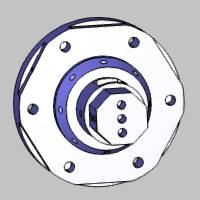
How to Change the View Options
These steps are provided here as they apply to one or more of the examples that follow.
To turn on and off the Transparent view:
- In the document toolbar, click the drop down list next to the
 icon, and select
icon, and select  Transparent.
Transparent. - You can also use the shortcut key T. Just click anywhere in the graphics area, to give it key focus, and press the T key to toggle the transparent view.

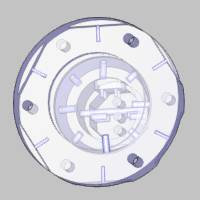
To turn on and off the Shaded view:
- In the document toolbar, click
 Shaded.
Shaded. - You can also use the shortcut key S. Just click anywhere in the graphics area, to give it key focus, and press the S key to toggle the shaded view.

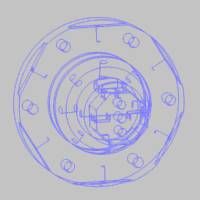
To turn on and off the Wireframe view:
- In the document toolbar, click the drop down list next to the
 icon, and select
icon, and select  Wireframe.
Wireframe. - You can also use the shortcut key W. Just click anywhere in the graphics area, to give it key focus, and press the W key to toggle the wireframe view.

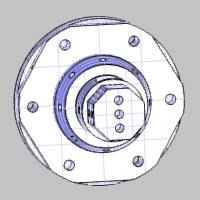
Transparent View
Select Edges Through Transparent Faces
Utilizing the transparent view option during selection allows you to select surface edges through the transparent faces of the model. This can greatly reduce the need to zoom in and out and rotate the model for many parts and selection scenarios.
Tip: Turning on the transparent view is a great way to confirm the selections you have made, because it shows selections that may be covered by other surfaces (when transparency is off).

When the transparent view is on, you can still select geometry as you normally would, but you can also then select edges that are behind the transparent faces of the model.
When you point to a surface (and there are no edges behind the mouse pointer), it highlights for selection.
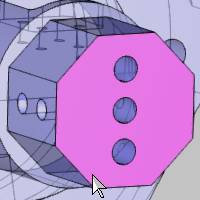
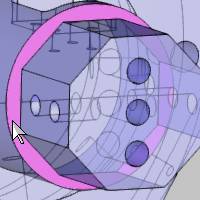
When the mouse pointer is moved to a surface edge that sits behind a transparent face, the edge highlights for selection.
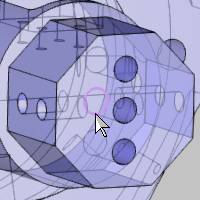
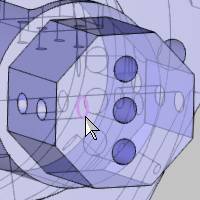
Shaded View
Turn Off Surface Shading to Select Edges Only
The shaded view option is helpful for geometry selection because it removes the shading of surfaces leaving only surface edges available for selection. This method can be very helpful for CAD and CAM, but specifically CAD functions, such as extrude boss, when you need to select wireframe geometry that is on a surface.
Tip: In addition, turning off the shaded view is a great way to confirm the selections you have made, because it shows selections that may be covered by other surfaces (when shaded is on).

When the shaded view is turned off, you can easily select any surface edge of the model (and surfaces do not highlight). You can also easily select wireframe geometry that is on a surface as the surface does not highlight.
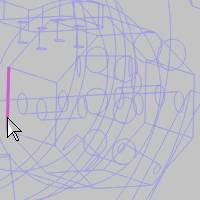
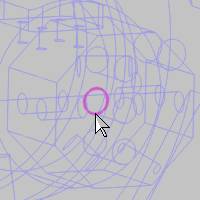
Shaded and Wireframe Views
Surface Selection
This section explains a special case tip for selecting surfaces from a part model, specifically very small surfaces. Turning off the shaded view and turning on the wireframe view allows you to easily select surfaces by clicking the wireframe, which in many scenarios can greatly reduce the need to pan, zoom, and rotate the viewing orientation of the part, and it still allows for selection of surface edges. For our example part, the selection of very small cylindrical surfaces is greatly improved.
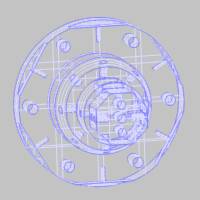
For our example part, there are six small holes on the outside diameter of the part that require rotating and zooming to select all of the cylindrical surfaces. Using the shaded and wireframe views allows these selections to be made from a single viewing orientation.
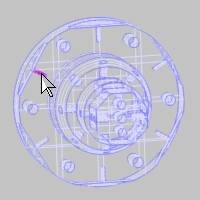
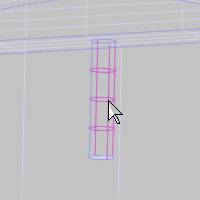
This concludes the example.






